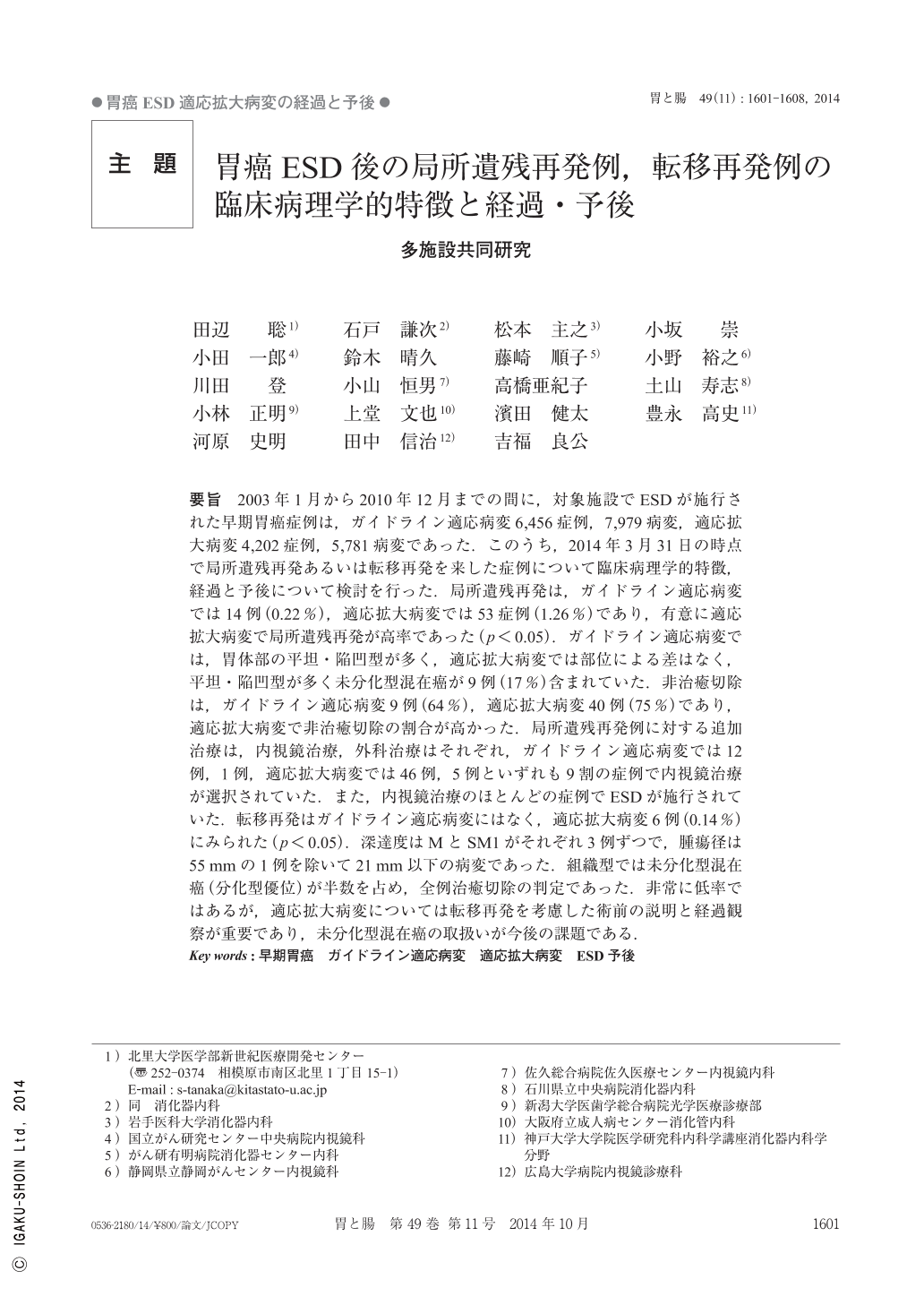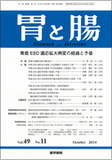Japanese
English
- 有料閲覧
- Abstract 文献概要
- 1ページ目 Look Inside
- 参考文献 Reference
- サイト内被引用 Cited by
要旨 2003年1月から2010年12月までの間に,対象施設でESDが施行された早期胃癌症例は,ガイドライン適応病変6,456症例,7,979病変,適応拡大病変4,202症例,5,781病変であった.このうち,2014年3月31日の時点で局所遺残再発あるいは転移再発を来した症例について臨床病理学的特徴,経過と予後について検討を行った.局所遺残再発は,ガイドライン適応病変では14例(0.22%),適応拡大病変では53症例(1.26%)であり,有意に適応拡大病変で局所遺残再発が高率であった(p<0.05).ガイドライン適応病変では,胃体部の平坦・陥凹型が多く,適応拡大病変では部位による差はなく,平坦・陥凹型が多く未分化型混在癌が9例(17%)含まれていた.非治癒切除は,ガイドライン適応病変9例(64%),適応拡大病変40例(75%)であり,適応拡大病変で非治癒切除の割合が高かった.局所遺残再発例に対する追加治療は,内視鏡治療,外科治療はそれぞれ,ガイドライン適応病変では12例,1例,適応拡大病変では46例,5例といずれも9割の症例で内視鏡治療が選択されていた.また,内視鏡治療のほとんどの症例でESDが施行されていた.転移再発はガイドライン適応病変にはなく,適応拡大病変6例(0.14%)にみられた(p<0.05).深達度はMとSM1がそれぞれ3例ずつで,腫瘍径は55mmの1例を除いて21mm以下の病変であった.組織型では未分化型混在癌(分化型優位)が半数を占め,全例治癒切除の判定であった.非常に低率ではあるが,適応拡大病変については転移再発を考慮した術前の説明と経過観察が重要であり,未分化型混在癌の取扱いが今後の課題である.
In this study, we investigated patients with early gastric cancer who underwent ESD(endoscopic submucosal dissection)at 11 institutions between January 2003 and December 2010. Subjects were 6,456 patients(7,979 lesions)who met the absolute indication and 4,202 patients(5,781 lesions)who met the expanded indication for ESD. Of these, clinicopathological features, progress, and prognosis were investigated in those patients in whom local recurrence or metastatic recurrence was identified as of March 31, 2014. Local recurrence was identified in 14 patients(0.22%)who met the absolute indication and in 53 patients(1.26%)who met the expanded indication, indicating a significantly higher rate of recurrence in patients meeting the expanded indication(p<0.05). Most absolute indication lesions were flat and depressed in the gastric corpus, and expanded indication lesions included 9 cases(17%)of undifferentiated mixed type. Non-curative resection was performed in 64% of patients meeting the absolute indication and 75% of patients meeting the expanded indication, indicating that a higher percentage of non-curative resections were performed in patients meeting the expanded indication. Adjuvant therapy in cases of local recurrence included 12 cases of endoscopic treatment and 1 case of surgical treatment among patients meeting the absolute indication and 46 cases of endoscopic treatment and 5 cases of surgical treatment among patients meeting the expanded indication. In both groups, endoscopic treatment was chosen in 90% of cases, and most of these were eligible for ESD. No patients meeting the absolute indication had metastatic recurrence, and although there were 6 cases(0.14%)of metastatic recurrence among the patients meeting the expanded indication, all 6 of these patients underwent curative resection. There were 3 cases each of lesions with invasion depths of M and SM1, and excluding 1 case in which the lesion diameter was 55mm, all lesions were 21mm or less. The histological type of half of the lesions was undifferentiated mixed type. Although very rare, it is important to provide preoperative explanations of the possibility of metastatic recurrence and conduct follow-up for patients with lesions meeting the expanded indication. Treatments for mixed-type lesions will need to be investigated in a future study.

Copyright © 2014, Igaku-Shoin Ltd. All rights reserved.


